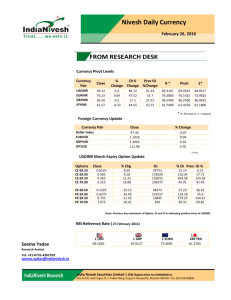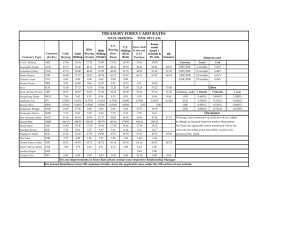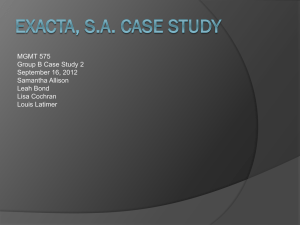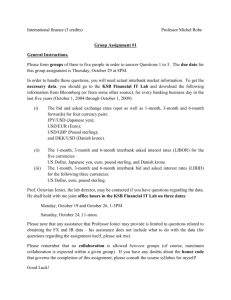FX SPOT 1. Market Conventions
advertisement
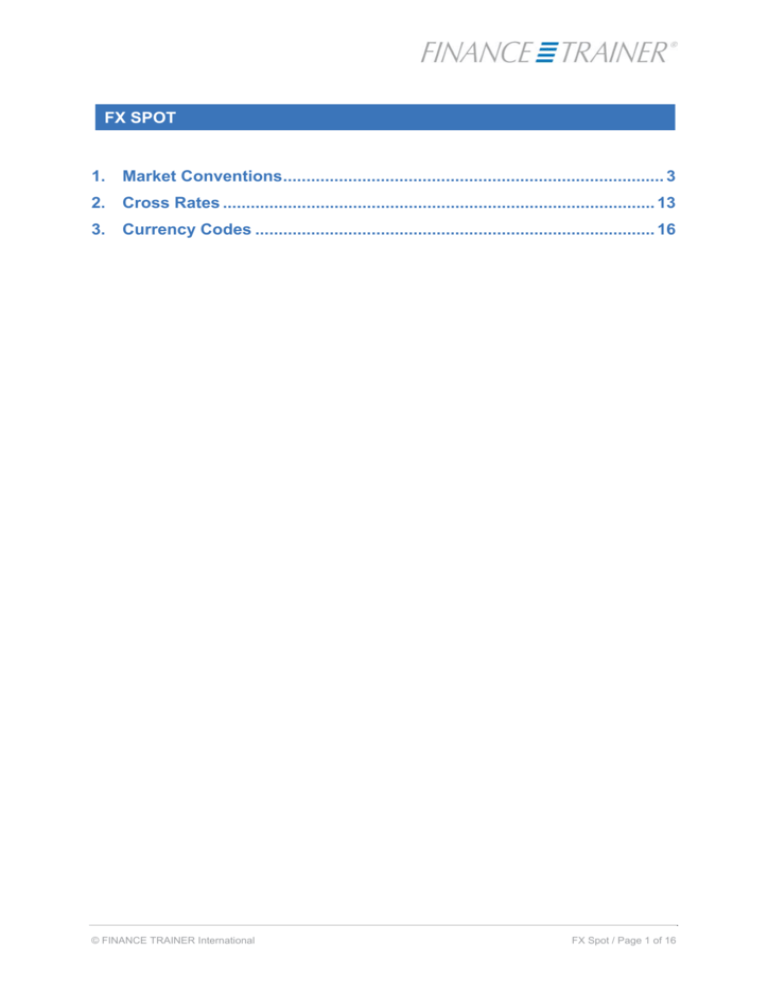
FX SPOT 1. Market Conventions.................................................................................. 3 2. Cross Rates ............................................................................................. 13 3. Currency Codes ...................................................................................... 16 © FINANCE TRAINER International FX Spot / Page 1 of 16 FX SPOT A spot FX transaction is the purchase or sale of one currency for another, with delivery usually two days after the dealing date. Below you can see a Reuters screen which shows spot rates for various currencies against the USD. The different expressions will be discussed in detail on the next pages. Big figure Swift Code quoting bank © FINANCE TRAINER International bid rate pips offer rate FX Spot / Page 2 of 16 1. Market Conventions The exchange rate at which the spot transaction is done is called the "spot rate". Value date of spot transactions The delivery day of a spot transaction is called value date. Business days do not include Saturdays, Sundays or bank holidays in either of the countries of the two currencies involved. If the "normal" value date (two days after the dealing date) falls on a public holiday in one of the centres of the currencies involved, the next working day is taken as the value date for the transaction. A USD/JPY spot transaction - with dealing date on Wednesday the 4th of January -would normally have value date on Friday, the 6th of January. If however the 6th of January is a public holiday in Japan or in the US, the value date will be deferred to Monday the 9th of January. There are however some exceptions to these general rules: USD-CAD-transactions are often dealt on a so-called "funds"-basis. This means that delivery will be done 1 working day after the dealing date. FX markets in the Middle East are closed on Fridays but open on Saturdays. A USDSAR transaction could therefore have a split settlement date, with the USD delivered on Friday and the SAR delivered on Saturday. Before implementation of the Euro the value date of cross transactions (FX spot deals not involving the USD) could have been deferred due to US public holidays. Since Euro implementation US public holidays are more and more disregarded in value dates of cross transactions. © FINANCE TRAINER International FX Spot / Page 3 of 16 Swift Codes Each currency can be identified by a three-letter code. The first two letters refer to the name of the country. The third letter refers to the name of the currency. These codes are used by the Swift message system and have become international accepted standards. The major currencies and their swift codes are listed in the appendix. For some currencies nicknames are rather common among dealers. Of course the correct swift code should be used when confirming a trade. GBP/USD: Cable CHF: Swissi SEK: Stocki AUD: Aussi, Ozzy NZD: Kiwi Base currency and quote currency Spot rates are quoted as one unit of the base currency (= base currency) against a number of units of the quote currency (also variable currency or counter currency). 1 unit of base currency = x units of quote currency When spot rates are quoted, the first currency always represents the base currency (base currency) and the second currency is the quote currency / variable currency. Base currency Quote currency / Variable Currency EUR/USD Euro US-Dollar USD/CZK US-Dollar Czech Crown © FINANCE TRAINER International FX Spot / Page 4 of 16 If the spot rate quoted for EUR/USD is 1.0850, this means that one Euro is worth 1.0850 USD. Bid and offer rates Spot rates are usually quoted in two rates, the bid rate and the offer rate. EUR/USD 1.0850/1.0860 or EUR/USD 1.0850-60 or EUR/USD 50-60 The bid rate is the rate at which the bank quoting the price (the market maker) is ready to buy the base currency from the market user (the counterpart asking for a price). The offer rate is the price at which the market maker will sell the base currency to the market user. Market Maker Bid Rate: buys base currency Offer rate: sells base currency sells quote currency buys quote currency Market User Bid rate: sells base currency Offer rate: buys base currency buys quote currency sells quote currency The market user is the counterpart asking for prices. The market user may be a corporation, an institutional investor, a bank or the central bank. If a dealer receives a call from another bank, in order to make a quote, he acts as the market maker. If the same dealer is calling another bank in order to ask for prices he acts as the market user. The market maker has the risk of changing rates while quoting, so that afterwards he possibly cannot close his position without loss. © FINANCE TRAINER International FX Spot / Page 5 of 16 In order not to be confused by the different dimensions (market maker/market user, bid/offer, base currency/quote currency) we suggest the following procedure: I. Adjust the question to be answered for the base currency This means e.g. for a EUR/USD quotation and a question where USD are bought (or sold), the question should be adjusted to EUR to be sold (or bought). II. Adjust the question to be answered to market user/market-maker. Market-maker (quoting bank) buys at bid rate and sells at offer rate. Market-user (bank asking for a quote) buys at offer rate and sells at bid rate. You want to buy USD 10 m against EUR. Four different banks quote you the following prices: Bank A: 1.0830 - 40 Bank B: 1.0850 - 60 Bank C: 1.0800 - 10 Bank D: 1.0790 - 00 Where do you buy your USD? I. The base currency is the EUR. You want to buy USD, meaning you sell EUR. II. You ask for the rate. You act as market user and sell EUR at the highest bid rate at 1.0850 to Bank B. Thus you buy USD 10 m at the rate of 1.0850 and pay EUR 9,216,589.86. (10,000,000/1.0850). © FINANCE TRAINER International FX Spot / Page 6 of 16 Reuters Conversation Here you can see a typical Reuters Conversation in the FX Spot Market: #EUR USD 10 12 14 #URS OK TO CONFIRM I BUY EUR 10 MIO AGAINST USD AT 1.1512 MY EUR DIRECT PLS #TO CONFIRM I SELL EUR 10 MIO AGAINST USD AT 1.1512 #MY USD TO CITI N.Y. PLS #THKS VM AND BIBI #END REMOTE Explanation A hash (#) at the beginning of a line marks your own text. #EUR USD 10 This bank is asking for a rate for EUR 10 m against USD. Usually you do not tell if you want to buy or sell. 12 14 This bank is quoting the pips of bid and offer rate (market maker).As market participants normally know the big figure, it is left out when quoting so you can save time (FX Spot Market is the fastest market of the world !). In this case we assume that the regular rate is 1.1512 – 1.1514. #URS The asking bank deals and sells EUR 10 m at the bid rate (market user). At the same time it buys USD at 1.1512 (i.e. 10,000,000 x 1.1512 = 11,512,000 USD). “URS” is a common abbreviation for “yours” which means “I sell” (opposite “mine” for “I buy”). © FINANCE TRAINER International FX Spot / Page 7 of 16 OK TO CONFIRM I BUY EUR 10 MIO AGAINST USD AT 1.1512 MY EUR DIRECT PLS The quoting bank confirms the deal and gives payment instructions for the EUR it receives. #TO CONFIRM I SELL EUR 10 MIO AGAINST USD AT 1.1512 #MY USD TO CITI N.Y. PLS #THKS VM AND BIBI #END REMOTE The asking bank confirms the deal as well and gives payment instructions for the USD it receives. The bank thanks for the deal; the conversation is ended. Broker Banks can not only trade directly with each other but also via broker. A broker acts as an agent for the two counterparties and receives a brokerage for his service. This brokerage depends on the traded volume, i.e. 10 USD brokerage per traded million EUR would be for 10 m: 10 x 10 = 100 EUR. The broker’s advantage is the bigger market depth compared to the one-to-one direct trading in the interbank market as with a broker you have a lot more potential counterparties at the same time. In contrary to his customers the broker never takes trading positions. You can distinguish between voice brokers and electronic brokers resp. broking systems. A voice broker is a real human being who trades with banks via open telephone line (or Reuters Conversation). He informs his customers about the actual quotes all the time. If a bank trades on a broker’s price, a deal is done between this bank and the bank which quoted the price (if they both have enough limit for each other). The broker then confirms the deal with both of them and additionally sends a written confirmation to both counterparts as well. An electronic broker resp. an electronic broking system works like a voice broker but the quotes and deals are done through a special system. The best known systems are Reuters 3000 and EBS. Also these systems check if both banks have enough limit to deal with each other. The more banks with big limits have been put to the system, the better prices are for the user (bid/offer spread is smaller), the better his liquidity is. All banks log in with so-called Dealing Codes, a code with four letters (e.g. CITL = Citi London). If two counterparts trade in one of these systems you call it “matching”, i.e. the system checks the quotes of the dealing codes and matches them if it finds identical numbers. Then the system prints a confirmation for both counterparties. © FINANCE TRAINER International FX Spot / Page 8 of 16 Spread The spread is the difference between the bid and offer rates. Currency Pairs Buying Rate (Bid) Selling Rate (Offer) USD/CHF 1,4720 1,4730 EUR/USD 1,0125 1,0130 USD/CZK 30,210 30,220 USD/NOK 7,4500 7,4800 CHF/JPY 86,760 86,800 USD/JPY 105,80 105,90 USD/SEK 6,7270 6,7300 GBP/USD 1,5585 1,5595 GBP/JPY 195,70 195,90 The rates shown are examples for the bid and offer rates for interbank spot deals. For customers, spreads are normally a little wider. If USD/CHF is quoted 1.4720 / 30, the bid rate is the buying price quoted for the USD (or selling price for the CHF). The offer rate is the selling price for the USD (or the buying price for the CHF). Long-, short-, square-position Banks / dealers of foreign currency, have a long, short or square position in the different currencies. A long position in a currency means that the dealer has bought more of the currency than he has sold. If this position is taken purposely the dealer expects the currency to rise. Having sold more than bought the dealer speaks of a short position in a currency. The expectation will normally be that of a declining rate. A square or a flat position in one currency means that the dealer has bought and sold the same amount of currency and has no risk if the rates change. © FINANCE TRAINER International FX Spot / Page 9 of 16 Direct / indirect quote In the international markets most currencies are quoted against the USD. In this case the USD is usually the base currency (e.g. USD/CHF, USD/NOK, USD/CZK, USD/PLN, USD/JPY, etc). However there are some exemptions to this rule: e.g. GBP/USD, EUR/USD, AUD/USD. In the home market it is sometimes more convenient to reverse the quoting conventions. The method to quote CZK against CHF may in this case be in Prague different to Zurich. In a direct quote the home currency is the quote currency and the foreign currency is the base currency. Frequently the quote is done for 100 units of the quote currency. example: direct quote for CZK in Zurich: CZK/CHF 4.8075 (i.e. 100 CZK cost 4.8075 CHF) direct quote for CHF in Prague: CHF/CZK 20.800 (i.e. 1 CHF costs 20.800 CZK) In an indirect quote the home currency is the base currency and the foreign currency is the quote currency. example: indirect quote for CHF in Prague: CZK/CHF 4.8075 indirect quote for CZK in Zurich: CHF/CZK 20.800 The indirect quote is the reciprocal value (1 divided by) of the direct quote. In order to get an indirect quote the following rules have to be observed: The bid of the indirect quote is the reciprocal value of the offer rate of the direct quote. The offer of the indirect quote is the reciprocal value of the bid rate of the direct quote. Rates indirect quote Bid Rate Offer Rate 1 Offer direct 1 © FINANCE TRAINER International Bid direct FX Spot / Page 10 of 16 In New York the direct quote for GBP is: GBP/USD 1.6200 – 1.6210 The corresponding indirect quote in New York may be computed: USD/GBP USD/GBP, bid rate: 1 = 0.6169 1.6210 USD/GBP, offer rate: 1 = 0.6173 1.6200 Pips and Big Figure An FX quote usually consists of five digits EUR/USD 1.1510 USD/CHF 1.3160 AUD/USD 0.6455 USD/JPY 117.15 USD/CZK 27.323 etc. The last two digits of the spot rate are the so-called pips. The rest of the spot quotation is called big figure. Pips EUR/USD 1.1510 Big Figure Pips USD/JPY 116.15 Big Figure © FINANCE TRAINER International FX Spot / Page 11 of 16 In general the pip is one hundredth of one hundredth of a currency USD 0.0001 EUR 0.0001 CHF 0.0001 However, some exceptions can be observed in the markets. For a USD/JPY quotation one pip is one hundredth of a JPY (JPY 0.01). In day-to-day business, spot dealers assume that, every counterpart knows the big figure of the given quotation. Hence, spot rates are often quoted only with their pips. As this may be rather dangerous (especially in very volatile markets), the code of conduct recommends to indicate the big figure for every deal. © FINANCE TRAINER International FX Spot / Page 12 of 16 2. Cross Rates A cross rate is the quote for a currency pair which does not include the USD (e.g. EUR/CHF, GBP/JPY etc.). In the professional spot markets most of the deals are done with the USD as the base currency. Since some years however, cross deals have increased in importance. Every cross rate can be computed by using the corresponding USD quotes. Following rates are quoted in the market: USD/CHF: 1.4980-1.4985 USD/NOK: 6.3272-6.3292 Using the quote of CHF and NOK against the USD, the NOK/CHF cross rate can be calculated. First we determine the base currency for the desired cross rate. In this example we chose NOK. Bid rate In order to compute the NOK/CHF bid rate (at which we sell NOK against CHF) we have to do the following transactions: (1) We sell NOK 1 and buy USD 0.1580 (at 6.3292) (2) We sell USD 0.1580 and buy CHF 0.23668 (1.4980) + NOK - + USD 0.1580 1 - + 0.1580 (1) CHF - 0.23668 (2) (3) (3) Result: When selling NOK 1 you receive CHF 0.23668. Thus the bid rate NOK/CHF is 0.2367. © FINANCE TRAINER International FX Spot / Page 13 of 16 Offer rate In order to compute the NOK/CHF offer rate (at which we buy NOK against CHF) we have to do the following transactions: (1) We buy NOK 1 and sell USD 0.15805 (at 6.3272) (2) We buy USD 0.15805 and sell CHF 0.23683 (at 1.4985) + NOK - 1 + USD 0.15805 - + 0.15805 CHF 0.23683 (1) (2) (3) (3) Result: By buying NOK 1 you pay CHF 0.23683. Thus the NOK/CHF offer rate is 0.2368. Rules for calculating cross rates The simple case USD is the base currency for one currency pair and quote currency for the other currency pair (“cross-over”). EUR/USD: 1.1500-10 USD/CHF: 1.4980-85 you want to quote EUR/CHF. As EUR is the base currency and CHF the quote currency for the cross rate you do not have to change the quotes above. EUR/CHF bid Æ multiplication of bid rates: 1.1500 x 1.4980 = 1.7227 EUR/CHF ask Æ multiplication of ask rates: 1.1510 x 1.4985 = 1.7248 (If you had to quote CHF/EUR, you would have to calculate as stated above and then compute the reciprocal rate in the end.) © FINANCE TRAINER International FX Spot / Page 14 of 16 The complex case USD is the base currency resp. quote currency for both currency pairs. USD/CHF: 1.4980-85 USD/NOK: 6.3272-92 Æ you want to quote NOK/CHF Step 1: Conversion USD/NOK in NOK/USD In order to make NOK the base currency calculate the reciprocal quotation of USD/NOK (if you had to quote CHF/NOK you would have to compute the reciprocal value of USD/CHF). NOK/USD bid: 1 = 0.15800 6.3292 NOK/USD ask: 1 = 0.15805 6.3272 Step 2: After Step 1 the currency is quoted „cross over“again. Thus you can proceed like in the above stated “simple case”: NOK/CHF bid Æ multiplication of the bid rates: 1.4980 x 0.15800 = 0.2367 NOK/CHF ask Æ multiplication of ask rates: 1.4985 x 0.15805 = 0.2368 © FINANCE TRAINER International FX Spot / Page 15 of 16 3. Currency Codes Three letter currency codes are used to represent currencies. In most cases, the first two letters of the currency code represent the country and the last one represents the currency. CAD: CA stands for Canada and D for Dollar JPY: JP stands for Japan and Y for Yen The ISO (International Organization for Standardization) publishes a worldwide standard for currency codes (ISO 4217). Usually, these codes are used by SWIFT as well. Thus these currency codes are frequently called ISO-codes or SWIFT-codes. Currency codes of ACI member countries Americas Argentina Bahamas Canada Mexico USA Asia Pacific Australia Hong Kong India Indonesia Japan Korea (Republic of) Macau Malaysia New Zealand Pakistan Philippines Singapore Sri Lanka Thailand AUD HKD INR IDR JPY KRW MOP MYR NZD PKR PHP SGD LKR THB Europe Austria Belgium Channel Islands Croatia Cyprus Czech Republic Denmark Finland France Georgia Germany Greece EUR EUR GBP HRK EUR CZK DKK EUR EUR GEL EUR EUR © FINANCE TRAINER International ARS BSD CAD MXN USD Europe Hungary Iceland Ireland Israel Italy Luxembourg Macedonia Malta Monaco Netherlands Norway Poland Portugal Romania Russia Serbia & Montenegro Slovakia Slovenia Spain Sweden Switzerland United Kingdom Middle East and Africa Bahrain Egypt Jordan Kenya Kuwait Lebanon Mauritius South Africa Tanzania Tunisia United Arab Emirates HUF ISK EUR ILS EUR EUR MKD EUR EUR EUR NOK PLN EUR RON RUB RSD EUR EUR EUR SEK CHF GBP BHD EGP JOD KES KWD LBP MUR ZAR TZS TND AED FX Spot / Page 16 of 16


